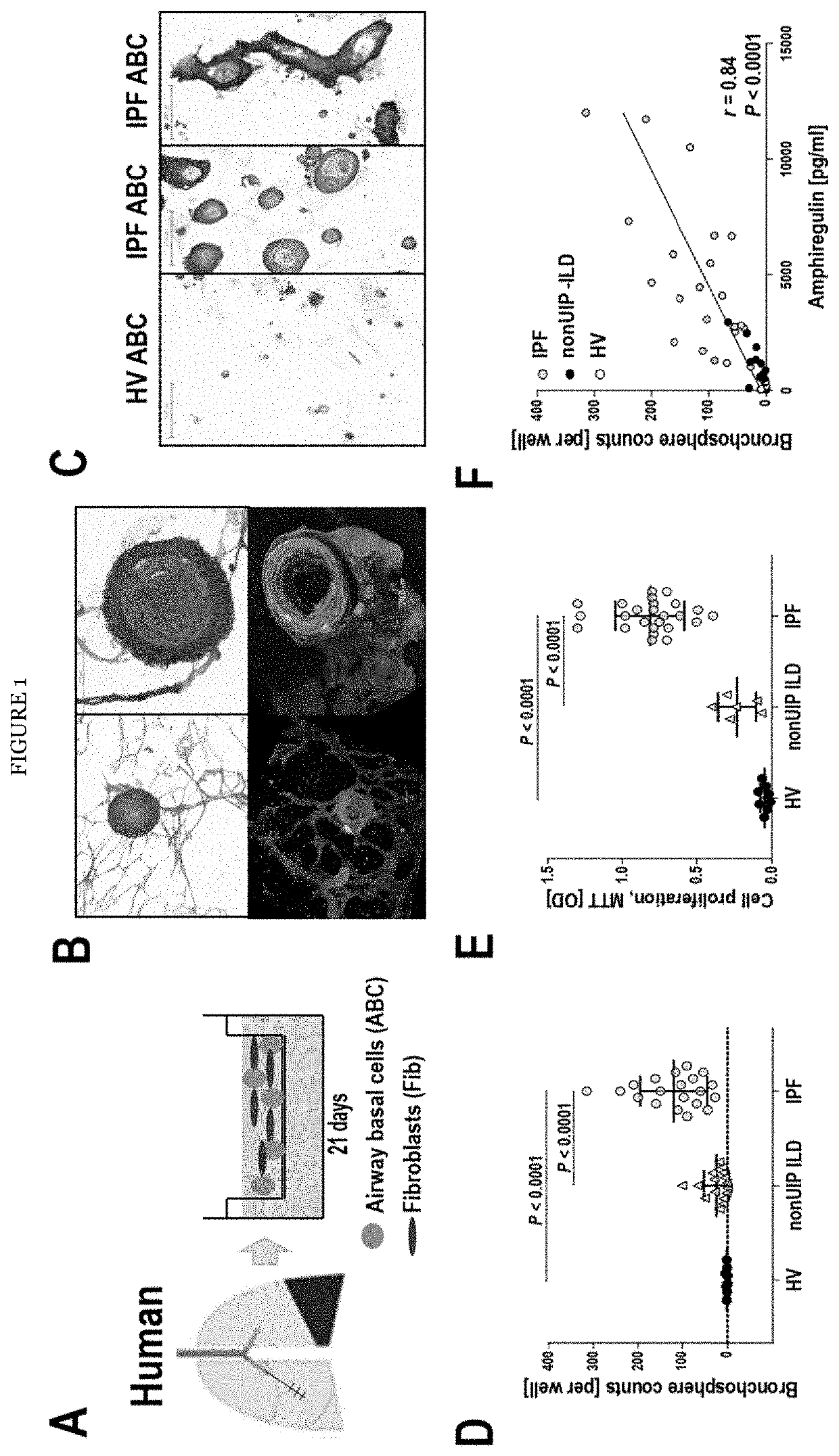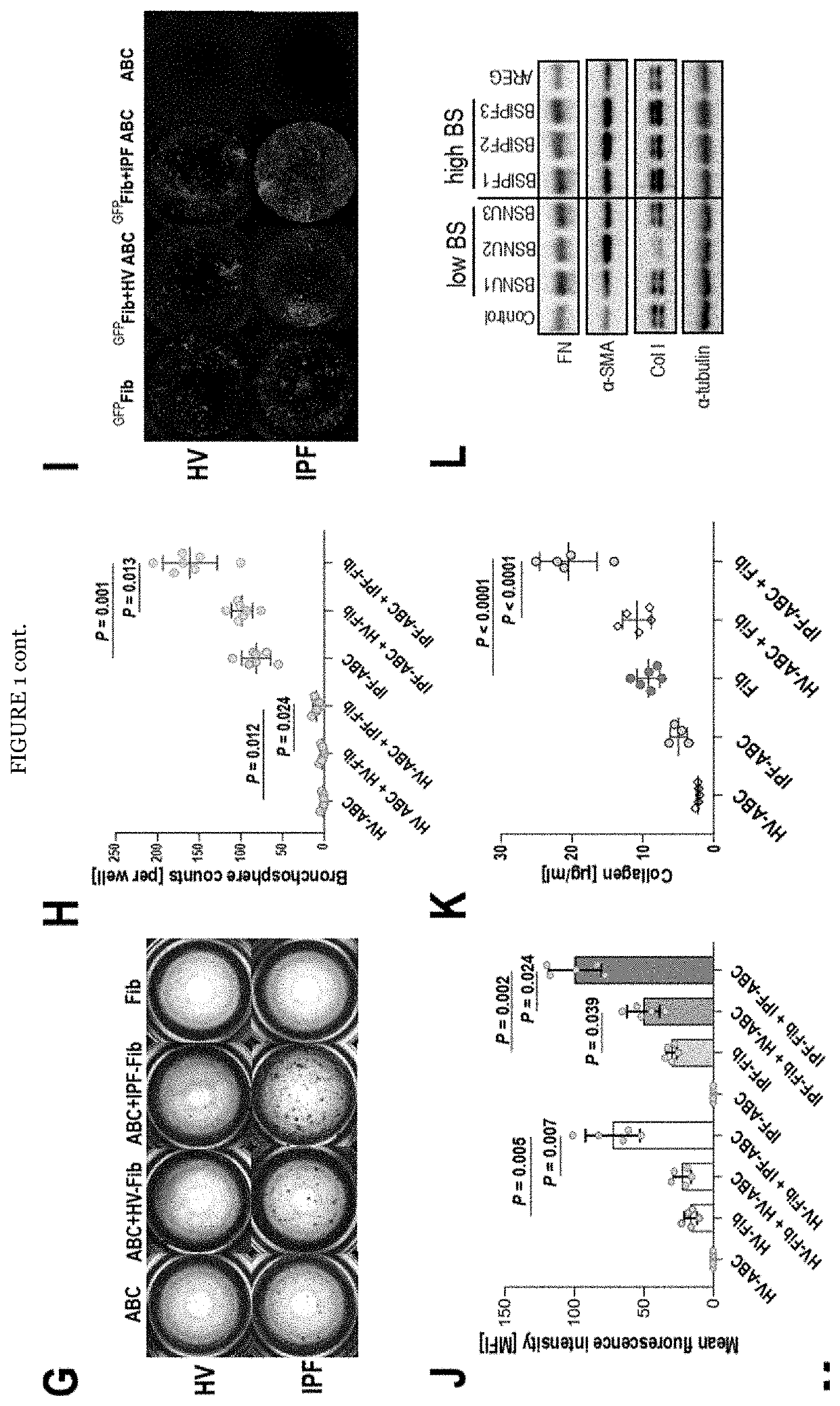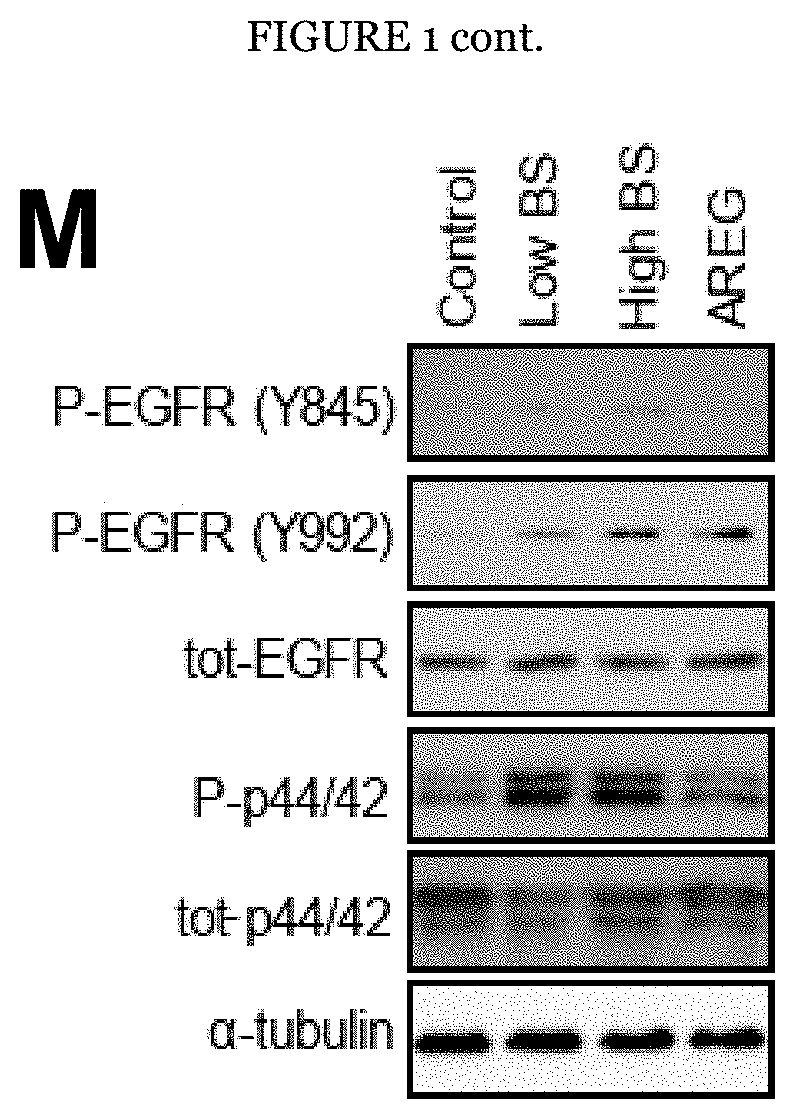Modulators of airway basal cells for the treatment or prevention of lung diseases
a technology of basal cells and modulators, which is applied in the direction of instruments, drug compositions, material analysis, etc., can solve the problems of not being clear whether, and no therapeutic option that tackles and prevents the occurrence of lung diseases, and achieve the effect of reducing and/or inhibiting
- Summary
- Abstract
- Description
- Claims
- Application Information
AI Technical Summary
Benefits of technology
Problems solved by technology
Method used
Image
Examples
example 1
IPF Patients Generate Significantly more Bronchospheres than ABCs from Healthy Volunteers or nonUIP Interstitial Lung Disease (ILD) Patients in a 3D Organoid Model
[0096]The inventors compared the bronchosphere formative capacity of ABCs from patients with IPF (IPF-ABC) to those obtained from healthy volunteers (HV-ABC) or individuals with fibrotic nonUIP ILD (NU-ABC) by plating the cells in 3D culture for 21 days (FIG. 1A-D). After 21 days, all three cell types formed organoids in 3D culture; however IPF-ABC formed organoids that were multilayered and frequently contain hollow and tube-like structures, visually resembling bronchospheres (FIGS. 1B and C). The average number of spheres per well generated by IPF-ABCs was significantly higher compared to HV-ABCs or NU-ABCs (120±73, 24±26 or, 2±2, respectively; P<0.0001, FIG. 1D). In addition, cell proliferation as measured at day 21 by MTT assay was also highly increased in IPF-ABCs compared to HV-ABCs and NU-ABCs (P<0.0001, FIG. 1E). B...
example 2
of Fibroblasts Increased Bronchosphere Formation and IPF-ABCs Stimulated Fibroblast Proliferation and Collagen Production
[0097]To assess the interaction of fibroblasts and ABCs the inventors added primary lung fibroblasts to our 3D cell culture system. IPF-ABCs formed bronchospheres similar to the ones observed before, which were now surrounded by a mesh of fibroblasts (FIG. 1B). Presence of lung fibroblasts in the 3D cell culture system, particularly primary cells derived from IPF explants, significantly enhanced bronchosphere formation of ABCs (P=0.012 and P=0.001, FIGS. 1G and H). Using GFP-transduced fibroblasts, we found that the overall fluorescence was significantly increased by IPF-ABCs in healthy (HV-Fib) as well as IPF fibroblasts (IPF-Fib), (P=0.005 and P=0.002 respectively, FIGS. 1I and J), potentially reflecting enhanced proliferation. IPF-ABCs significantly increased collagen production by lung fibroblasts compared to HV-ABCs (P<0.0001, FIG. 1K). Stimulation of lung fi...
example 4
ll Sequencing of IPF-ABCs and NU-ABCs Identifies SRC as a Potential Therapeutic Target
[0099]Single cell RNA sequencing (scRNASeq) was performed on cells obtained by bronchial brushing from nine IPF patients and six nonUIP disease controls. 14,873 epithelial single cell transcriptomes were profiled. Based on expression profiles of known marker the inventors identified four epithelial cell populations in the brushed cells (FIG. 3A-C): ciliated cells (FOXJ1, HYDIN, 41.5% of all epithelial cells), secretory cells (SCGB1A1, SCGB3A1, 10.5%), ABCs (TP63, KRT5, 47.1% of cells) and ionocytes (STAP1, PDE1C, 0.8% of cells) and focused the analysis on the basal cell.
[0100]Gene expression of IPF-ABC was substantially different from NU-ABC (1,099 genes at FDR<0.05, FIG. 3D). The IPF basal cell subpopulation was characterized by an increased expression of stem cell markers and stemness increasing signal transduction factors such as FOSL1, KLF4, MYC, CD24 (FIGS. 3D and E), expression of KRT17 and s...
PUM
| Property | Measurement | Unit |
|---|---|---|
| body weight | aaaaa | aaaaa |
| body weight | aaaaa | aaaaa |
| body weight | aaaaa | aaaaa |
Abstract
Description
Claims
Application Information
 Login to View More
Login to View More - R&D
- Intellectual Property
- Life Sciences
- Materials
- Tech Scout
- Unparalleled Data Quality
- Higher Quality Content
- 60% Fewer Hallucinations
Browse by: Latest US Patents, China's latest patents, Technical Efficacy Thesaurus, Application Domain, Technology Topic, Popular Technical Reports.
© 2025 PatSnap. All rights reserved.Legal|Privacy policy|Modern Slavery Act Transparency Statement|Sitemap|About US| Contact US: help@patsnap.com



